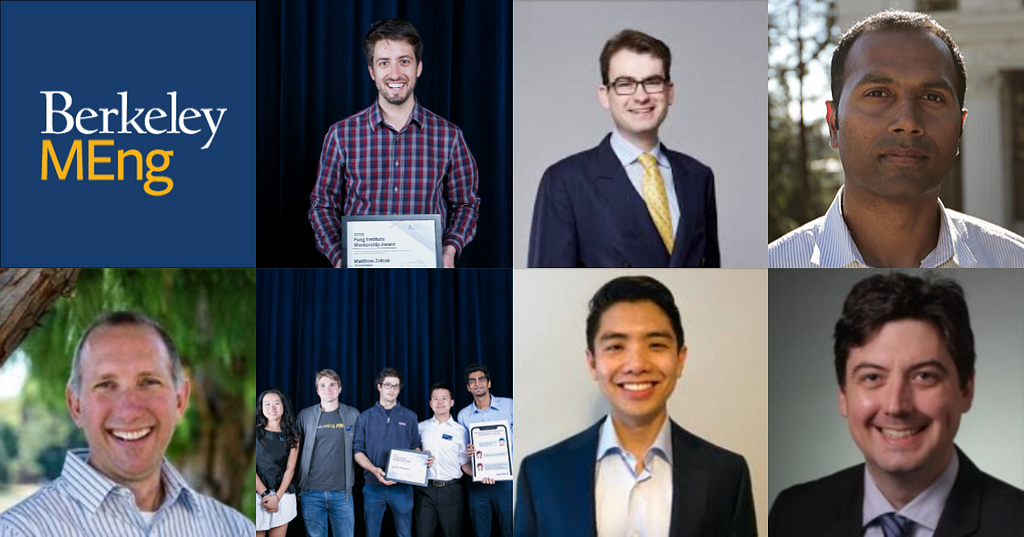By Alex Beliaev
One of the distinguishing characteristics of MEng Capstone projects is the possible number of project stakeholders:- Individual students who may want to leverage their Capstone experience to pivot professionally
- Academics who may rely on MEng talent to commercialize their research
- Industry advisors who may look to the MEng team to test product development ideas
- Community leaders who may need engineering expertise to address societal challenges
Inaugural Mentorship Awards
2019 marks the launch of MEng Capstone Mentorship Awards. The awards give MEng students an opportunity to recognize Capstone advisors who foster intellectual independence, professional development, and provide project support.
Tip #1: Propose a project that leverages MEng students’ leadership skills.
“I’d say what sets Berkeley MEng students apart is not only a willingness, but an eagerness to take on real-world engineering problems with all of their associated baggage. With other students, I may have felt guilty bringing them a problem with such a broad scope, asking them to use data with quality issues, and requiring that they deal with company bureaucracy and an advisor living across the country. However, these students are eager to understand what it’s like to tackle engineering problems in the real world so they can enter the workforce prepared, even if it means dealing with logistical annoyances you’d never see in an academic setting. This is a unique quality that will set these students up to be ahead of the game in industry, and leaders wherever they go.” — Matt Zebiak, General MotorsTip #2: When recruiting your team, leverage the diversity of the MEng cohort.
“MEng students are all smart and are incredibly diverse (probably a function of having so many international students) — there are some out there with unique viewpoints and a great work ethic, who want to dive into a particular subject. Some come in with deep skill sets in one area which they want to improve, others come in with no experience in the area that they want to learn about…One thing that I am quite proud of is the academic diversity of our team. Unlike some of our previous teams, we didn’t focus too much on the concentration of the student, but instead on their interests.” — Douglas Hutchins, Squishy RoboticsTip #3: Communicate the value of the proposed project. Make it a practice to revisit and reiterate your goal throughout the year.
“Capstone students have lots of other time commitments. If the students realize that this Capstone project is adding a lot of value, is a lot of fun, and is challenging, then they are committed to put in more time… Convey the end-goal of the project, and lay down a path of how to get there, and what it involves in the very first meeting with the students. This way, the student can always visualize the final result and work hard towards it.” — Prof. Koushil Sreenath, Mechanical EngineeringTip #4: Set objectives that will inspire, support, and further opportunities for teaming and collaboration.
“I remember coming in on a Sunday to help the students with measurements on the scanning electron microscopy [SEM]. The equipment is heavily used so this was when we could get time on the SEM. What was great about this was that I expected the student I was working directly with to be present, but the whole group showed up and was very engaged… The MEng students are in general much more outgoing and engaging than the typical PhDs.” — Prof. Matt Sherburne, Materials Science & EngineeringTip #5: Set project timelines that support students’ Capstone integration coursework: reporting, project management, and teaming deliverables.
“Be aware that project materials may need to be shared with individuals outside the project team which may have implications on legal aspects and team timeline for deliverables. Set up a collaborative work environment where you can provide feedback as needed and not have to rely only on weekly meetings. This will accelerate iterations.” — Damien Thioulouse, AsurionTip #6: Create an opportunity for your Capstone team to meet your internal stakeholders.
“We had the team come in to our office for a mid-year presentation to our entire company. It was at the same time that we were announcing our Series A funding, so it was great to see the team present their progress over the course of the year, and also have them be a part of one our biggest company milestones. With such a small team, everyone, from our founders to our Capstone team members, played a role in where and who we are today, so it was really nice that we were all together for that moment.” — Kevin Feng, Beam SolutionsTip #7: Communicate how your Capstone team’s work will be taken-up in the future.
“Our project pertained to smart utility systems and fiber optic networks for broadband access in rural America. It was very “blue-sky” and open-ended. As such, their biggest contribution was narrowing the types of solutions, such as machine learning for electric load prediction, that we will pursue next year…. Next year’s team will probably have a narrower focus on a particular topic that this year’s team identified. We might ask them to pursue the load prediction tool, building off of this year’s work.” — Seth Hoedl, The Post Road Foundation If you are interested in proposing a Capstone project, visit our Propose a Project page or contact Alex Beliaev at alexb@berkeley.edu.How to sponsor a successful Capstone project: 7 tips from Capstone advisors was originally published in Berkeley Master of Engineering on Medium, where people are continuing the conversation by highlighting and responding to this story.





